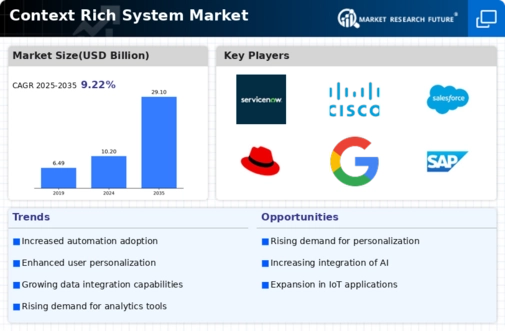Increased Focus on Automation
The Context Rich System Market is benefiting from an increased focus on automation across various industries. Organizations are recognizing the potential of context-rich systems to streamline operations, reduce costs, and enhance efficiency. Automation technologies, such as robotic process automation (RPA) and intelligent automation, are being integrated into context-rich systems to facilitate seamless workflows. Recent statistics indicate that companies implementing automation can achieve productivity gains of up to 30 percent. This trend is driving the demand for context-rich solutions that can adapt to dynamic environments and provide real-time insights. Consequently, the Context Rich System Market is poised for growth as businesses seek to harness the power of automation to remain competitive.
Advancements in Machine Learning
The Context Rich System Market is experiencing a notable surge due to advancements in machine learning technologies. These innovations enable systems to analyze vast amounts of data in real-time, enhancing decision-making processes across various sectors. For instance, the integration of machine learning algorithms allows for improved predictive analytics, which is crucial for businesses aiming to optimize operations. According to recent data, the machine learning market is projected to grow at a compound annual growth rate of over 40 percent, indicating a robust demand for context-rich applications. This growth is likely to drive investments in the Context Rich System Market, as organizations seek to leverage these technologies to gain competitive advantages and improve customer experiences.
Growing Demand for Personalization
The Context Rich System Market is witnessing a growing demand for personalized experiences across various sectors, including retail, healthcare, and finance. Consumers increasingly expect tailored services that cater to their individual preferences and needs. This trend is prompting businesses to adopt context-rich systems that utilize data analytics to deliver customized solutions. For example, in the retail sector, companies are employing context-aware systems to analyze customer behavior and preferences, leading to enhanced customer satisfaction and loyalty. Market data suggests that personalized marketing strategies can yield conversion rates that are up to six times higher than traditional approaches. As a result, the Context Rich System Market is likely to expand as organizations prioritize personalization in their service offerings.
Expansion of Internet of Things (IoT)
The Context Rich System Market is experiencing growth due to the expansion of the Internet of Things (IoT). As more devices become interconnected, the volume of data generated is increasing exponentially. Context-rich systems are essential for managing and analyzing this data, enabling organizations to derive meaningful insights from IoT applications. For instance, in smart cities, context-aware systems can optimize resource allocation and improve public services by analyzing data from various sensors. Market forecasts suggest that the IoT market will reach trillions of dollars in value, further propelling the demand for context-rich solutions. This expansion indicates a promising future for the Context Rich System Market as it adapts to the evolving landscape of IoT technologies.
Rising Importance of Real-Time Data Processing
The Context Rich System Market is increasingly influenced by the rising importance of real-time data processing. As organizations strive to make informed decisions swiftly, the ability to process and analyze data in real-time has become paramount. Context-rich systems that can deliver timely insights are essential for industries such as finance, healthcare, and logistics, where delays can result in significant consequences. Market analysis indicates that the demand for real-time analytics solutions is expected to grow substantially, with projections suggesting a market size increase of over 25 percent in the coming years. This trend underscores the necessity for context-rich systems that can provide actionable insights promptly, thereby driving growth in the Context Rich System Market.

















Leave a Comment